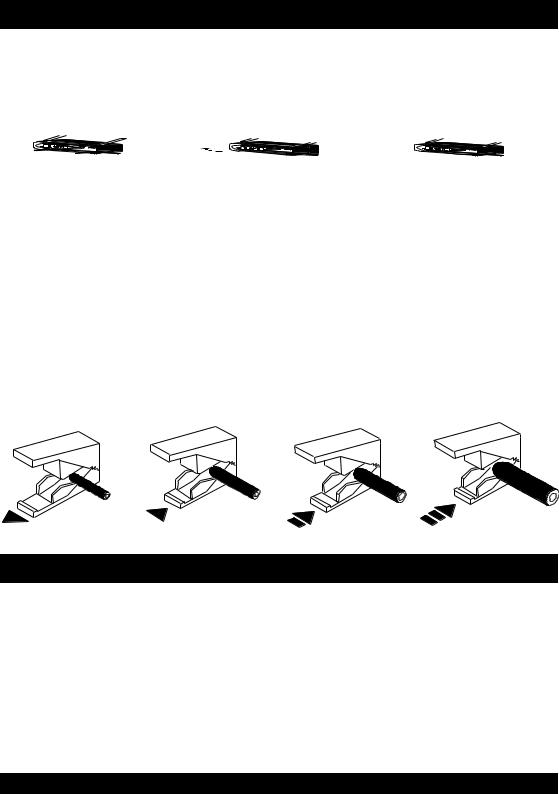Watson-Marlow 501RL User Manual

Publication PB 0167
Issue 4
Installation and operating instructions
501RL, 205, 505BA and 505L pumpheads
2

Table of Contents
Declarations .................................................... |
Page 4 |
Two year warranty .................................................... |
Page 5 |
Information for returning pumps .................................................... |
Page 5 |
Safety .................................................... |
Page 5 |
Recommended operating procedures ............................................. |
Page 6 |
Part 1 : 501RL pumphead |
|
Description .................................................... |
Page 7 |
Installation .................................................... |
Page 7 |
Roller adjustment .................................................... |
Page 7 |
Tube loading .................................................... |
Page 8 |
Care and maintenance .................................................... |
Page 8 |
Spares .................................................... |
Page 9 |
501RL flow rates .................................................... |
Page 9 |
Tubing range .................................................. |
Page 10 |
Part 3: 205BA & 505BA pumpheads |
|
Description .................................................. |
Page 11 |
Installation .................................................. |
Page 11 |
Flow rates .................................................. |
Page 11 |
Tube range .................................................. |
Page 12 |
Cassette loading .................................................. |
Page 13 |
Cassette removal .................................................. |
Page 13 |
Care and maintenance .................................................. |
Page 13 |
Spares 205BA & 505BA .................................................. |
Page 14 |
Part 5 : 505L pumphead |
|
Description .................................................. |
Page 15 |
Installation .................................................. |
Page 15 |
Flow rates .................................................. |
Page 16 |
Tubing range .................................................. |
Page 16 |
Tube loading .................................................. |
Page 17 |
Care and maintenance .................................................. |
Page 19 |
Adjustment of the track .................................................. |
Page 19 |
Spares and accessories .................................................. |
Page 20 |
Decontamination certificate .................................................. |
Page 21 |
3

Declaration of incorporation
Declarations
When the 501RL, 205BA, 505BA, and 505L pumpheads are to be used with any Watson-Marlow drive unit or any customer’s drive unit, or are to be installed into machines or assembled with other machines for installations, they must not be put into service until the relevant machinery has been
declared in conformity with the provisions of the Machinery Directive
2006/42/EC.
Responsible person: David Cole, Managing Director,
Watson-Marlow Limited, Falmouth, Cornwall TR11 4RU, England.
Telephone 01326 370370 |
Fax 01326 376009 |
|
|
|
|
4

Two year warranty
Watson-Marlow Limited warrants, subject to the conditions below, through either Watson-Marlow Limited, its subsidiaries, or its authorised distributors, to repair or replace free of charge, including labour, any part of this product which fails within two years of delivery of the product to the end user. Such failure must have occurred because of defect in material or workmanship and not as a result of operation of the product other than in accordance with the instructions given in this manual.
Conditions of and specific exceptions to the above warranty are:
•Consumable items such as rollers and cassettes are excluded.
•Products must be returned by pre-arrangement carriage paid to Watson-
Marlow Limited, its subsidiaries, or its authorised distributor.
•All repairs or modifications must have been made by Watson-Marlow Limited, its subsidiaries, or its authorised distributors or with the express permission of Watson-Marlow Limited, its subsidiaries, or its authorised distributors.
•Products which have been abused, misused, or subjected to malicious or accidental damage are excluded.
Warranties purporting to be on behalf of Watson-Marlow Limited made by any person, including representatives of Watson-Marlow Limited, its subsidiaries, or its distributors, which do not accord with the terms of this warranty shall not be binding upon Watson-Marlow Limited unless expressly approved in writing by a Director or Manager of Watson-Marlow Limited.
Information for returning pumps
Any equipment which has been contaminated with, or exposed to, body fluids, toxic chemicals or any other substance hazardous to health must be decontaminated before it is returned to Watson-Marlow or its distributor.
A certificate (a suitable blank form is included at the rear of these operating instructions), or signed statement, must be attached to the outside of the shipping carton.
This certificate is required even if the pump is unused. If the pump has been used, the fluids that have been in contact with the pump and the cleaning procedure must be specified along with a statement that the equipment has been decontaminated.
Safety
In the interests of safety, these pumpheads and the tubing selected should only be used by competent, suitably trained personnel after they have read and understood this manual, and considered any hazard involved.
Any person who is involved in the installation or maintenance of this equipment should be fully competent to carry out the work. In the UK this person should also be familiar with the Health and Safety at Work Act 1974.
5

Recommended operating procedures
Do keep delivery and suction lines as short as possible.
Do use the minimum number of bends in rigid pipe runs. If there must be a bend, use a swept bend and not a tight elbow.
Do use suction and delivery pipelines with a bore equal to or larger than the bore of the tube fitted in the pumphead. When pumping viscous fluids, the losses caused by increased friction can be overcome by using pipe runs with a cross sectional area several times greater than the pumping element.
Do run at a slow speed when pumping viscous fluids. When using the 501RL pumphead, a 4.8 or 6.4mm bore tube with a 1.6mm wall will give best results. Tube smaller than this will generate a high friction pressure loss, so reducing the flow. Tube with a larger bore will not have sufficient strength to restitute.
Flooded suction will enhance pumping performance in all cases, particularly for materials of a viscous nature. Silicone and Marprene tubing is available with a 2.4mm wall thickness for speeds up to 220rpm. (The rotor will require re-setting to a roller/track gap of 3.8mm.)
Do use the largest possible bore tube running at slow speed for the longest tube life.
Do fit an extra length of pump tube in the system so that you can move the tube through the pumphead occasionally, without needing to break the pumping circuit. This is particularly useful for extending tube life in long running sterile applications.
Do keep the track and rollers clean, and ensure that the rollers are free.
Do not fit valves in the suction or delivery lines without considering that peristaltic pumps are self priming and will hold their prime up to several metres, so there may be no need for non-return or foot valves, nor for the loading valves required on many other kinds of pumps.
Any valves fitted must cause no restriction. If electrically actuated valves are fitted, they should be interlocked so that the pump will only run when the valves are open. Fit an automatic by-pass if manual valves are installed.
When using Marprene or Bioprene tubing, after about 30 minutes of running, re-tension the tube in the pumphead by releasing the tube clamp on the delivery side a little and pulling the tube tight. This is to counteract the normal stretching that occurs with Marprene or Bioprene, which can go unnoticed, and result in poor tube life.
Tube selection The chemical compatibility list published in the Watson-
Marlow catalogue is only a guide. If in doubt request a tube sample card for immersion trials. Remember the sample will be fully immersed, but the fluid when in use will only be in contact with the inside of the tube. If the material swells but does not lose its strength it could be worth considering.
Viscous dispensing To overcome the common problems, of reduced accuracy and dripping delivery pipes, the suction and delivery lines should be kept as short as possible. Use larger bore transmission tubes than in the pumphead to keep the friction losses to a minimum. Improvement will be noticed if rigid or semi-rigid pipe is used on the delivery side. The rigid tube is effective in reducing over-run because it does not expand during pumping.
6

Part 1 : 501RL pumphead
Description
The 501RL pumphead has two spring-loaded rollers, which automatically compensate for minor variations in tubing wall thickness, giving extended tube life.
The 501RL is set during manufacture to accept tubing with wall thicknesses of between 1.6mm and 2.0mm, and internal diameters of up to 8.0mm. The 501RL pumphead is equipped with a "tool lockable" guard for increased safety, this should be locked shut whilst the pump is in use.
A major feature of the 501RL pumphead is the ability to run the pumphead clockwise for extended tube life, or anti-clockwise to operate against higher pressures.
The tube clamps of the 501RL are adjustable to four positions to allow varying tube diameters to be securely held without occluding the tube.
Installation
Any one of three tubing input/output positions can be selected on cased drives. Select the required position then fit the track over the drive shaft and locating boss. Tighten the track retaining screw.
After checking that the shaft is clean and degreased slide the rotor on to it. Fit the track in any one of three orientations, over the drive and locating boss.
Secure the track with the locating screw. Ensure the drive shaft is degreased before locating the rotor onto the shaft via the split collet. Rotate rotor until its guide rollers are alligned flush to the front edge of the track. Tighten the rotor screw to a torque of 3Nm to prevent the collet slipping during operation.
To reposition the track, remove any tubing from the pumphead, and swing out the crank handle to expose the rotor retaining screw. Turn the screw anticlockwise one turn to release the collet, and withdraw the rotor from the shaft. Loosen the track locating screw, and pull the track clear. Rotate the track to its new position and tighten the track locating screw.
Roller adjustment
The 501RL has a factory set gap of 2.6mm between the rollers and the track and is suitable for tubing having wall thicknesses of between 1.6 and 2.0mm. Adjustment of the gap will be required if tubing having a wall thickness of less than 1.6mm is required. There is an adjusting screw on each of the two roller arms, and each of these screws will require adjustment. The correct gap is twice the wall thickness less twenty percent. Correct adjustment is important: over occlusion will reduce tube life; under occlusion will reduce pumping efficiency.
To change the gap setting, turn each adjusting screw clockwise to increase the gap, or anticlockwise to decrease the gap. A full turn changes the gap by
0.8mm.
To restore the original settings of 2.6mm, turn the adjusting screws until both rollers are just touching the track, then tighten each screw by three and a quarter turns.
7

Tube loading
Switch off the pump before loading the tube. Unlock and open the hinged guard and swing out the rotor crank handle until it locks into position.
Select the length of tubing required, noting that approximately 240mm is required for the track system (measured from the outside faces of the tube clamps).
Fit one end of the tubing into one of the spring loaded clamps, and then, whilst rotating the rotor with the crank handle, feed the tubing between the rollers and the track, aligning it within the rotor tube guides. The tubing must lie naturally against the track and must not be twisted or stretched.
Fit the other end of the tubing into the second spring loaded clamp, ensuring that the tubing is not slack in the pumphead, since this can reduce tube life.
Close the crank handle and shut and lock the guard. After the pump has been started, open the downstream clamp for a short time, so that the tube can find its natural length.
The 501RL pumphead is fitted with four-position tube clamps, to accommodate various tube diameters, which can be adjusted by pushing in or pulling out the bars at the top of the upper clamp and the bottom of the lower clamp. Set the clamps so that the minimum necessary pressure is applied to the tubing.
Care and maintenance
If aggressive liquids are spilled on to the pumphead, the head should be removed and cleaned using a mild solution of detergent and water. Remove any tubing from the pumphead, and swing out the crank handle to expose the rotor retaining screw. Turn the screw anticlockwise one turn to release the collet, and withdraw the rotor from the shaft. Unscrew the track retaining screw and detach the track from its spigot.
Check moving parts of the rotor regularly for freedom of movement. Lubricate pivot points and rollers with Teflon lubricating oil. To obtain effective lubrication of the roller spindle, remove from the pumphead and clean thoroughly prior to applying RD-105 grease.
8
